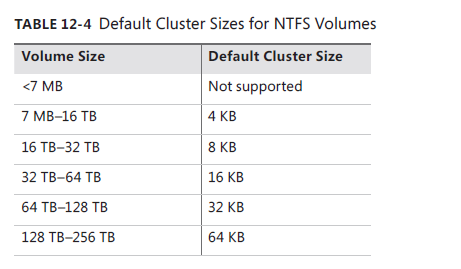翻译windows internals 第12章文件系统 (持续更新)NTFS
2016-06-07 15:59
489 查看
As noted at the beginning of the chapter, the NTFS file system is the native file system format of Windows. NTFS uses 64-bit cluster numbers. This capacity gives NTFS the ability to address volumes of up to 16 exaclusters; however, Windows limits the size of an NTFS volume to that addressable with 32-bit clusters, which is slightly less than 256 TB (using 64-KB clusters). Table 12-4 shows the default cluster sizes for NTFS volumes. (You can override the default when you format an NTFS volume.) NTFS also supports 232–1 files per volume. The NTFS format allows for files that are 16 exabytes in size, but the implementation limits the maximum file size to 16 TB.
正如最初的章节讲述,NTFS是windows原生文件系统格式。NTFS使用64位簇号。这个能力使得NTFS能寻址高达16艾字节簇。然而windows限制NTFS卷的大小,仅仅可以只用32位簇号寻址。然而,稍微少于256TB,(使用64KB大小的簇)。表12-4显示NTFS卷的默认簇大小.(当你格式化NTFS卷的时候,你可以覆盖默认值)。NTFS每卷也支持2^32-1个文件。NTFS允许文件大小为16艾字节,但是实现最大支持16TB。

NTFS包括包括许多特性,例如文件和子文件安全,备用数据流,磁盘配额,稀疏文件,文件压缩,符号链接和硬链接,支持事务性语义,交接点和加密。最显著的特征是可恢复性。如果一个系统意外停止,FAT卷的元数据会处于一种不一致的状态,导致大量文件和子文件数据不一致。NTFS的log会已一种事务性的方式记录元数据的改变,这样文件系统的结构可以被修理到一致的状态,没有文件和目录结构信息的丢失。(文件数据可能会丢失除非用户使用TFx,本章后文会讲到)。除此之外,windows的NTFS驱动也实现了自我治疗的机制,通过这种机制它会
正如最初的章节讲述,NTFS是windows原生文件系统格式。NTFS使用64位簇号。这个能力使得NTFS能寻址高达16艾字节簇。然而windows限制NTFS卷的大小,仅仅可以只用32位簇号寻址。然而,稍微少于256TB,(使用64KB大小的簇)。表12-4显示NTFS卷的默认簇大小.(当你格式化NTFS卷的时候,你可以覆盖默认值)。NTFS每卷也支持2^32-1个文件。NTFS允许文件大小为16艾字节,但是实现最大支持16TB。

NTFS包括包括许多特性,例如文件和子文件安全,备用数据流,磁盘配额,稀疏文件,文件压缩,符号链接和硬链接,支持事务性语义,交接点和加密。最显著的特征是可恢复性。如果一个系统意外停止,FAT卷的元数据会处于一种不一致的状态,导致大量文件和子文件数据不一致。NTFS的log会已一种事务性的方式记录元数据的改变,这样文件系统的结构可以被修理到一致的状态,没有文件和目录结构信息的丢失。(文件数据可能会丢失除非用户使用TFx,本章后文会讲到)。除此之外,windows的NTFS驱动也实现了自我治疗的机制,通过这种机制它会
相关文章推荐
- 详解HDFS Short Circuit Local Reads
- 如何重装TCP/IP协议
- Windows 8 官方高清壁纸欣赏与下载
- 谁是桌面王者?Win PK Linux三大镇山之宝
- 对《大家都在点赞 Windows Terminal,我决定给你泼一盆冷水》一文的商榷
- Windows Clang开发环境备忘
- 从Windows系统下访问Linux分区相关软件
- 对《大家都在点赞 Windows Terminal,我决定给你泼一盆冷水》一文的商榷
- Windows下搭建本地SVN服务器
- 使用Windows原生命令一键清空剪贴板
- windows用windeployqt发布qt quick application程序
- 利用开源软件打造自己的全功能远程工具
- Windows 8虚拟机不能全屏的解决方法
- Visual Studio 2012 示例代码浏览器 - 数以千计的开发示例近在手边,唾手可得
- Visual Studio 2012 示例代码浏览器 - 数以千计的开发示例近在手边,唾手可得
- 微软镜像下载
- windows server域用户提升到本地更高权限组中的方法
